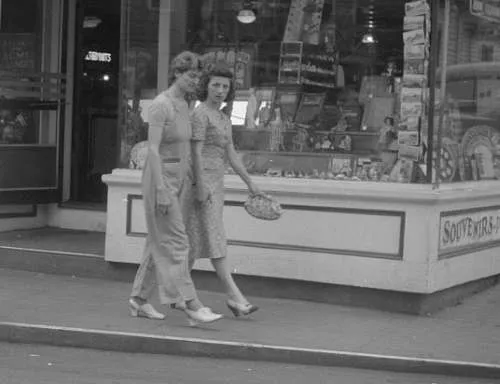The railroad, though, brought tourists to enjoy Provincetown’s wide, sandy beaches. So did the steamer from Boston and later, Route 6. Portuguese families discovered they could make a little extra money by taking in boarders. While the Portuguese men were away fishing, their wives accommodated visitors, often nice single men. They returned year after year, and they grew friendly with their hostesses.
From then and there, Provincetown was only a few steps away from becoming a gay mecca. But the town’s unique subculture had its roots in a long-ago past.

PTOWN, THE BEGINNING
Before they ever set foot on Plymouth Rock, the Pilgrims made landfall on the extreme northern tip of Cape Cod. They did a little exploring, stole a little Indian corn, signed the Mayflower Compact and then moved on to Plymouth.
But they realized the deep, sheltered harbor teemed with fish, and they took advantage of it. For the next decades, Plymouth Colony regulated and taxed the fishery, hoping to raise money for a school. The governor, Thomas Prence, got a deed for the land from local Indians in exchange for some blankets, kettles and tools.
Unlike other colonial towns, Ptown didn’t get a charter. And unlike other Puritan towns, it didn’t have to support a minister. The residents lived outside of the Puritans’ strict social order. Well outside.
Ptown was a transient, seasonal community, described as a wild place inhabited by “fishermen, smugglers, outlaws, escaped indentured servants, heavy drinkers and the ‘Mooncussers’.”
It’s unclear when year-rounders moved to Provincetown. In 1692, Massachusetts absorbed Plymouth Colony and Provincetown became known as the Province Lands. The Massachusetts General Court made those lands part of Truro, and then in 1727 incorporated the Town of Provincetown.
But again, Ptown retained its uniqueness. The Massachusetts General Court didn’t grant the inhabitants the right to own their land. They were allowed to squat in the built-up section, so long as they fished and farmed. But the colony owned the dunes and the scrub forest.
It wasn’t until 1893 that the General Court allowed the residents of Ptown to hold title to the land they lived on. So for 166 years, Ptowners were squatters.
PTOWN IN THE 19TH CENTURY
Throughout the 18th century, Provincetown’s population fluctuated. It reached about 200 people when the American Revolution started. But then the residents abandoned their homes during the war, as British warships would just sail in, stop the fishing and demand provisions.

Fishing families returned after the war, but the Embargo of 1807 and the War of 1812 interrupted its growth. Finally, when that war ended, Ptown came into its own.
The town grew steadily as whaling took off. By the 1840s the Portuguese, mostly from the Azores, began to arrive. Hired to work on whaling ships, they then followed the Yankees into fishing. They fished for herring, bass and mackerel in the harbor, and for cod off the Grand Banks and in the Bay of Chaleur.
Ptown prospered and grew. Its year-round population reached its zenith in 1875, with 4,357 people – about 50 percent more than today. By 1885, the town had 55 wharves and 114 schooners.
But then came hard times. Petroleum replaced whale oil, and whaling declined. Then the fisheries started to dwindle, and fishermen had poor catches in 1889. A depression followed in the 1890s, which caused fish prices to plummet. Then in 1898, a storm known as the Portland Gale wiped out nearly half of Ptown’s wharves and sunk 20 boats in the harbor. Businesses already struggling couldn’t afford to rebuild.
THE PILGRIM MONUMENT

But PTown was poised for the next chapter. Even before tourism dominated Ptown’s economy, hotels accommodated the mariners who spent most of their lives at sea. The town had four major hotels in the 19th century. It also had regular steamship service from Boston and, starting in 1873, a rail link from Wellfleet and the mainland.

T.
By then the colonial revival was in full flower, and the Yankees in town decided to make as much as they could of the Pilgrims’ five-week layover in the area. In 1910, the Cape Cod Pilgrim Memorial Association erected the Pilgrim Monument, and made much of the values of freedom and tolerance.
They might have chosen differently had they known what would come next. Within a few decades, “freedom” in Provincetown meant nude beaches, sex among the dunes, out-of-control parties, and flamboyant drag queens.
The playwright Tennessee Williams, then 29, arrived in the summer of 1940. He joined a group “dominated by a platinum blonde Hollywood belle named Doug and a bull-dike named Wanda who [was] a well-known writer under a male pen name.” Ptown, he wrote, was “screaming with creatures not all of whom are seagulls.”

.
LIGHT AND WATER
How did it happen?
Some of it had to do with Provincetown’s remoteness. Virtually surrounded by water, the town’s isolation let visitors shed their inhibitions in anonymity. They could do as they pleased without fear of discovery by the censorious community back home.
Some of it had to do with the clear Cape light, along with cheap boardinghouses and studios Charles Webster Hawthorne started the Cape Cod School of Art in Provincetown in 1899. Then the Summer School of Painting opened the next year. Free-thinkers from Greenwich Village began to flock to Ptown, including gay painters Marsden Hartley and Charles Demuth.

And some of it had to do with the Portuguese boardinghouse owners. Karen Christel Krahulik, in her research of Provincetown history, found that confirmed bachelors and maiden ladies formed trusting relationships with their Portuguese hosts and hostesses.
They returned year after year and became friends. “As long as sex- and gender-bending men and women were white and arrived with income to spare, Portuguese homeowners were pleased, more often than not, to take them in,” wrote Krahulik.

THE GREAT SUMMER OF 1916
Marsden Hartley called it “the Great Summer of 1916.” Many artists, like Hartley, had recently returned to America from Berlin, Paris and London because of World War I. They had experienced relaxed attitudes toward sex in those cities, and they liked it.
The artists flocked to Provincetown, which that year had six art schools. The Boston Globe ran a page one story headlined, “Biggest Art Colony in the World in Provincetown.”
But Provincetown was attracting writers as well as artists. Hartley had arrived in Ptown with a group of friends from Greenwich Village. They were into theater, Freud, Marx and free love. Among them were John Dos Passos, John Reed and Emma Goldman.
An unknown mariner, Eugene O’Neill, joined them, as well. His father was an actor and he had tried without success to find a stage for his plays. The year before the Greenwich Village group had formed an amateur theater company, the Provincetown Players. They agreed to put on O’Neill’s play Bound East for Cardiff. Unlike anything the audience had ever seen before, it revolutionized American theater.

Twenty four years later, another young playwright arrived in Ptown. It was 1940, and Provincetown was established as both a gay village and as an arts colony.
FOUR TYPES
Tennessee Williams later described the four groups who made up Provincetown’s residents. He belonged to the first two: The flamboyant gay summer visitors and the elite artists and writers who came to write, paint, dance or act. Third, gay wash-ashores who came as visitors and stayed year-round to work or run businesses. Finally, the Yankee, Portuguese and mixed-race native gays.
By the 1950s, an entertainment culture evolved, with nightclubs featuring drag acts. At Weathering Heights, for example, the waiters and waitresses cross-dressed, and the entertainment included female impressions.
In 1952, Provincetown selectmen enacted regulations that banned drag shows and forbade bars and restaurants from encouraging ‘the habitual gathering place for home-sexuals of either sex.’ “Selectmen Clamp Down on Gay Spots with New Regulations to Curb Evils,” reported the Provincetown Advocate in 1952. The regulations failed to curb any evils.

The selectmen then wrote a letter to the editor called “An Appeal to All decent People in the Town of Provincetown.” In it, they asked the town to get rid of the ‘nests where the homosexuals congregate.’ In July of 1960, the selectmen shut down the Weathering Heights club by denying the owner a liquor license.
Shopkeepers responded with their own “Shopkeepers Plea,” saying Provincetown was no longer a comfortable vacation spot and was becoming less interesting and less entertaining.
The shopkeepers won, and they’re still winning.
With thanks to Cape Queer? A Case Study of Provincetown, Massachusetts and Provincetown: From Pilgrim Landing to Gay Resort by Karen Christel Krahulik, and Ptown: Art, Sex, and Money on the Outer Cape by Peter Manso.
This story was updated in 2021.


